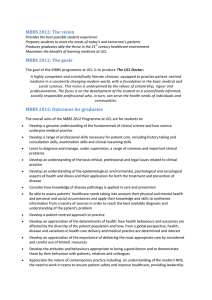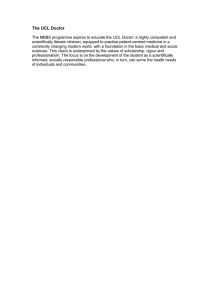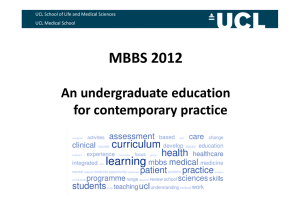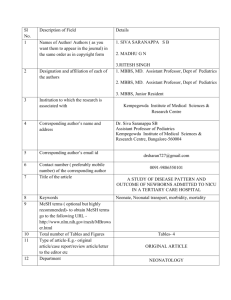MBBS 2012: An undergraduate education for contemporary practice
advertisement
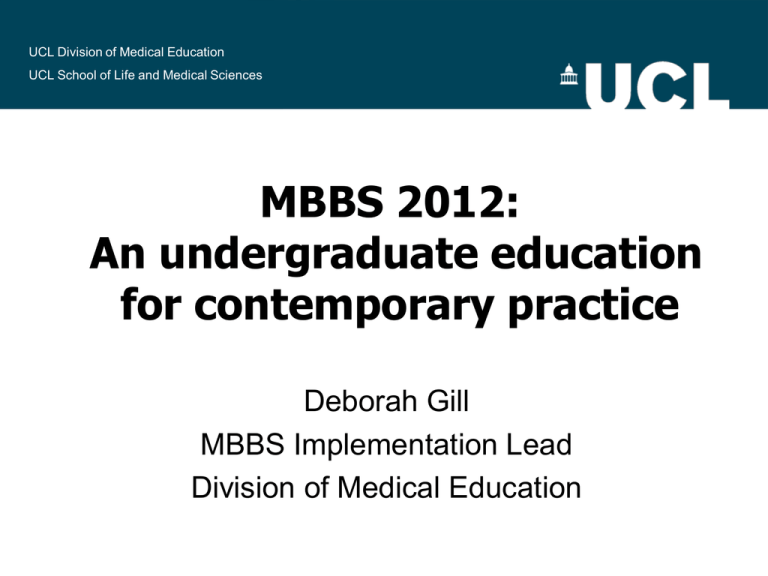
UCL Division of Medical Education UCL School of Life and Medical Sciences MBBS 2012: An undergraduate education for contemporary practice Deborah Gill MBBS Implementation Lead Division of Medical Education Why Change? • Students, institutions, curriculum guidance, theory and evidence all change over time • Intervening only when courses fail encourages a regressive attitude • Option for no change is not an option Why change? • Changes to the healthcare provider landscape • Changes in the practice of medicine • UCLP • The institutional mission of UCL MBBS 2012: The Vision • Provide the best possible student experience • Reflect the needs of today’s and tomorrow’s patients • Create 21st century doctors able to thrive in modern healthcare environments The UCL Doctor ‘A highly competent and scientifically literate clinician, equipped to practise patient-centred medicine in a constantly changing modern world, with a foundation in the basic medical and social sciences’ Features of the New MBBS Programme • The best possible student experience – More integration of the basic and clinical sciences – More small group work and use of the virtual learning environment, with a focus on synthesis of learning – BSc integrated into the MBBS programme – Attention to vertical themes throughout all years – Longer, more generic, clinical attachments – Contemporary assessments that are fair, relevant and help to prepare for practice and life long learning Features of the New MBBS Programme • The needs of today’s and tomorrow’s patients – Early extended patient contact – Focus on patient pathways – Preparation for practice: • Shadowing and assistantships – Focus on contemporary practice and UCLP priorities: • Social determinants of health • Mental health • Patient safety and quality improvement Features of the New MBBS Programme • Create 21st century doctors, able to thrive in modern healthcare environments – Preparation for practice: • Portfolio of learning • Exposure to a range of healthcare delivery venues and practices – Focus on contemporary practice and UCLP priorities: • Leadership & professional practice The UCL MBBS Programme 2012 PATIENT CENTRED LEARNING, STUDENT CENTRED LEARNING VERTICALLY ORGANISED MODULES OVERARCHING THEMES PROGRESSION Year 1 - Fundamentals of clinical science 1 Assessment Year 2 - Fundamentals of clinical science 2 Assessment Year 3 - Scientific method in depth ( iBSc ) Assessment Year 4 – Integrated clinical care Assessment Year 5 - Life cycle Assessment Year 6 - Preparation for practice Assessment Foundation Programme Horizontal Structures Year 1: Fundamentals of clinical science 1 Year 2: Fundamentals of clinical science 2 Year 3: Integrated BSc Year 4: Clinical care Year 5: The life cycle Year 6: The preparation for practice NC 1 & 2 Year 1& 2: Fundamentals of clinical science • Foundations module • Systems based • More vertical modules and integration (including early patient contact) • Post examination weeks – Preparation for the following year – Extended opportunities for early clinical practice • Portfolio and end-of-year assessment NC3 Integrated BSc • • • • Integrated, not intercalated: enhances learning on MBBS Taken by all students in year 3 Consistency across the courses with orientation to the practice of medicine Continued attention to vertical modules (portfolio and patient pathways) NC4 Integrated clinical care • Three 12-week blocks, based at the three central sites • Focus on understanding and providing clinical care in the modern NHS • Provide comparable experience rather than uniformity of experience: each site has a different ‘flavour’ • Light touch central organisation, allowing sites to play to their strengths but ensuring a core level of consistency & exposure • Modules link explicitly to the early years modules • Students maintain a portfolio of learning, including workplace-based assessment (WPBA) NC5 The life cycle • Three12-week blocks, based in the three central sites, rotating out to DGHs for placements • Modules link to the lifecycle • Child health and family health/primary care • Women’s health: (also includes men’s health) • Ageing and end of life care (plus specialist practice) • Continue to maintain portfolio of learning, including WPBA NC6 Preparation for practice • Two blocks of 16 weeks, mainly at distant sites • Focus on preparing for practice: student selected components, elective, student assistantships, education supervision and workplace based learning • Students submit a portfolio of learning, including WPBA • Finals earlier, allowing students the opportunity to re-sit and still take up Foundation post Vertical structures – Key to students’ understanding of medicine as an integrated whole – Delivered through a range of activities – Delivered both in centrally organised ‘peel-off’ activities and internally – module leads must ensure aspects of the vertical modules topics are addressed within the module and in workplace based learning: everybody’s business – Equivalent to approximately 1 day/week across the programme Vertical structures 1. Student centred learning, Patient centred learning – – – – Portfolios Student selected components & elective Patient Pathways (PPs) Extended Patient Contact (EPC) 2. Vertically organised modules – Integrated Vertical Strands (IVS) 3. Overarching themes – – – Synthesis & professional practice Mental health Social determinants of health Vertical structures: Student centred learning, Patient centred learning – Authentic e-portfolio – Mapping of SSCs: ensuring attainment of a range of skills and outcomes – Patient pathways (disease progression and management & care pathways), core presentations and extended patient contacts Patient Pathways • In all years • Most include an Extended Patient Contact • Relate to UCLP priorities • Link to Integrated Vertical Strands and Synthesis • PP topics : – Integrated/ community care – Chronic diseases – Cardio-metabolic disease – Cancer – Mental health – Pregnancy & newborn/Women’s health Extended Patient Contact • Throughout the programme, involving 3 to 5 contacts with one patient, supported by ongoing small group work • Topics: – – – – – Integrated /community care Cardio-metabolic diseases Cancer Mental health Mother and baby Vertical structures: vertically organised modules Integrated Vertical Strands: • Through all 6 years, linking to patient pathways & portfolio • Addressing factual knowledge connecting science & clinical medicine: – – – – – Pathological sciences Anatomy and imaging Use of medicines Use of Evidence Clinical skills and practical proceedures Vertical structures: Overarching themes – Synthesis & professional practice – Mental health – Social determinants of health Synthesis & professional practice Delivered mainly through: – Small group sessions – Virtual learning environment activities – Some plenaries – Case-of-the-month-type activities Addresses: – Scholarship & critical thinking – Professional skills – Teamwork, leadership, safety and quality of care Mental Health • An integrated vertical learning activity including elements of patient pathways, extended patient contact, integrated vertical strands and pockets of protected time and placements, bringing together a number of domains including: – – – – – – Psychology Social determinants of health An extended patient project Teaching on health and social care Liaison psychiatry Mental health problems in all horizontal modules and attachments – Dedicated short blocks of psychiatry experience in NC4&5 Teaching methods Assessment Cohesive strategy: – All years have in-course assessment managed via the portfolio and end-of-year progression tests – ‘Basket’ of assessments to ensure reliability and feasibility – Re-sits at key times: years 1, 2 and finals – Finals early enough (mid May) to allow a student to re-sit and graduate the same year and take up their Foundation post Countdown to MBBS 2012 • Less than 1 year to go! • Period of transition: intensive work by module leads and other lead teachers • Communication, communication, communication http://www.ucl.ac.uk/medicalschool/staff-students/mbbsnew-curriculum • With learning oriented around patient pathways and increase in vertical activities, need new ways of thinking about teaching and careful thought about the way learning experiences are organised Implications for educators • • • • • • • • • Change needs careful management Flexible timetables & placements must be designed Staff development is crucial Must work with a range of potential placements providers Web 2.0 and the VLE must be fully embraced An integrated curriculum needs clear mapping Ensuring patients are involved is vital Student experience must be at the heart of all decisions Ongoing curriculum management and development after 2012 must be ensured MBBS 2012: An undergraduate education for contemporary practice
